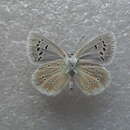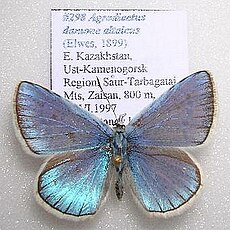en
names in breadcrumbs


Polyommatus damone is a butterfly found in the Palearctic that belongs to the blues family.
L. damone Ev. (81 h). At once distinguished from damon by the quite different tint of the blue in the male: the name-typical form, moreover, has a narrow black border. The white mesial streak of the hindwing beneath is either absent or present, but in the latter case is mostly much less conspicuous, diffuse, obsolescent or shortened. Female above dark brown, usually with obsolescent reddish yellow submarginal spots on the hindwing. In the southern Ural. ab. damocles H.-Schaff. [now full species] is a rare aberration whose male is smaller, very bright sky-blue bearing on the thin black border of the hindwing dark triangles resembling diffuse marginal dots. — damonides Stgr. (81 h, i) [now full species] from Transcaucasia and Persia (e. g. at Shahrud) is larger, darker above and beneath, the ground-colour of the underside being dark chocolate-brown : the white mesial streak, though prominent, is thinner and shorter. — sibirica Stgr. (= altaica Elw. from the Altai, is smaller and has the base of the wings more brightly dusted with blue beneath. — carmon H.- Schaff.[now full species] (=kindermanni Led., alpestris Frr., eurypilus Gerh.) (81 i) is much smaller than all the other forms of damone; the male bright cyaneous blue with broad black border to the forewing. From Asia Minor (Taurus), Armenia and Persia. — transcaspica Stgr. [now full species] is lighter blue above and darker brown beneath: from Turkestan. — In cyanea Stgr.[now full species] the male has nearly the same colour as the male of icarus, with distinctly black veins and thin black border; the costal area is a lighter blue and contrasts with the rest of the wing. Armenia. — xerxesStgr. [cyanea ssp.] , from Shahrud in Persia, is still smaller, the underside paler with the mesial streak entirely obsolete or nearly. — iphigenia H.-Schaff. (81 i) [now full species] is again similar to damon, above more greenish blue, with broad black border, the costal and apical areas of the hindwing also being black. The underside is paler and has smaller ocelli. Asia Minor and Persia. — iphidamon Stgr. (81 i) [now full species] is somewhat larger than the preceding form and the dark border is deeper black: from the Taurus, Kurdistan and Persia. — juldusa Stgr. (= iphigenia Alph.) [now full species] (82 a) is more greenish blue above, the black scaling so extends from the black border over the blue ground that the border gradually fades away. From the Tian-shan. According to Alpheraky very local and flying about a low plant with blue flowers. — iphigenides [now full species] (melania Gr.-Grsh. ) 82a Much larger than juldusa above very similar to iphigenia, but both sexes beneath with yellowish red marginal spots on the hindwing. Turkestan. — melania Stgr.[now full species] Upperside of male more green, with very broad border; the underside yellowish grey, with larger ocelli and yellowish red submarginal spots on both wings: from the Pamir. — The butterflies of this species are always local, some races appearing to have a very restricted distribution. They fly in May and June, particularly in desolate stony places where Oxytropis grows, and occur up to 10 000 ft.[2]
The larva feeds on Onobrychis arenaria, Hedysarum candidum, H. biebersteinii, H. cretaceum, H. grandiflorum, H. argyrophyllum
Named in the Classical tradition. Damone is a Greek male name Damon (Damon), an Athenian musician and philosopher of the time of Dionysus.
Polyommatus damone is a butterfly found in the Palearctic that belongs to the blues family.
 Polyommatus damone altaicus
Polyommatus damone altaicus
Polyommatus damone is een vlinder uit de familie Lycaenidae. De wetenschappelijke naam is voor het eerst geldig gepubliceerd in 1841 door Eversmann.
De soort komt voor in Europa.
Polyommatus damone is een vlinder uit de familie Lycaenidae. De wetenschappelijke naam is voor het eerst geldig gepubliceerd in 1841 door Eversmann.
De soort komt voor in Europa.
Вид поширений в Україні, степовій частині Росії та на заході Монголії. В Україні трапляється у степовій і лісостеповій зона, Гірському Криму. З Центральної і Східної України описаний підвид Polyommatus damone tanais Dantchenko et Pljushtch, 1993, а з Криму — вузькоареальний ендемік Polyommatus damone pljushtchi (Lukhtanov et Budashkin, 1993), який інколи підносять в окремий вид Polyommatus pljushtchi.
Довжина переднього крила 13-17 мм. У самців крила на верхній стороні блакитного кольору, блискучі, з тонкою темною крайовою лінією; у самиці — коричневого кольору. Верхівка передніх крил округлена. Нижня сторона крил у самця сіра, на задньому крилі розвинене блакитне прикореневе напилення. У самиці нижня сторона крил світло-коричнева. Крайовий малюнок низу крил виразний. На задніх крилах вздовж жилки М3 може біти нечіткий розпливчастий білий штрих; іноді він відсутній.
Метелики літають з середини травня до середини вересня. Трапляються на степових ділянках, луках, полях. За рік буває 1-2 покоління. Самиця відкладає по одному яйцю на нижню частину листя кормових рослин. Інкубація триває 5 днів. Кормовою рослиною гусені є представники роду Hedysarum. Гусениці зеленого або світлого бірюзового забарвлення. Над ногами у гусениці проходить рожева або біла смуга. Тіло гусениці покрито недовгими білими волосками. По досягненню довжини 14-16 мм гусениця перестає харчуватися і шукає притулок у ґрунті. Через 3-4 діб гусениця заляльковується. Фаза лялечки триває 9 діб.
Бабочки летают с конца мая- по сентябрь в 1-2 поколениях в зависимости от участка ареала. Бабочки быстро и низко летают над открытыми участками, присаживаются на разные цветущие растения. Кормовые растения гусениц: Hedysarum[1].
Яйцо дискообразное с мелко ячеистой структурой поверхности. Цвет яйца белый. Самки откладывают по одному яйцу на нижнюю поверхность листьев кормовых растений гусениц. Стадия яйца длится 5 дней. Гусеница желто-зеленого или светло-зеленого цвета. Зимует гусеница. Гусеницы старших возрастов питаются листьями и цветами кормовых растений. При достижению длины 14-16 мм гусеницы перестают питаться и окукливаются. Куколка длиной 9-11 мм, удлиненная, блестящая, зеленого цвета, с темной спинной полосой. Стадия куколка длится 9 дней.
В Красной книге Международного союза охраны природы (МСОП) вид имеет 3 категорию охраны (VU — уязвимый таксон, находящиеся под угрозой исчезновения в перспективе, в силу морфофизиологических и/или поведенческих особенностей, делающих их уязвимыми при любых, даже незначительных, изменениях окружающей среды).
Включен в «Красную книгу Европейских дневных бабочек» с категорией SPEC3 — вид, обитающий, как в Европе, так и за ее пределами, но находящийся на территории Европы под угрозой исчезновения[1].
Бабочки летают с конца мая- по сентябрь в 1-2 поколениях в зависимости от участка ареала. Бабочки быстро и низко летают над открытыми участками, присаживаются на разные цветущие растения. Кормовые растения гусениц: Hedysarum.
Яйцо дискообразное с мелко ячеистой структурой поверхности. Цвет яйца белый. Самки откладывают по одному яйцу на нижнюю поверхность листьев кормовых растений гусениц. Стадия яйца длится 5 дней. Гусеница желто-зеленого или светло-зеленого цвета. Зимует гусеница. Гусеницы старших возрастов питаются листьями и цветами кормовых растений. При достижению длины 14-16 мм гусеницы перестают питаться и окукливаются. Куколка длиной 9-11 мм, удлиненная, блестящая, зеленого цвета, с темной спинной полосой. Стадия куколка длится 9 дней.